Septic Tank Installation Cost
Last updated 23rd April, 2025
Do you need to know the cost of installing a septic tank?
Whether you're after a small above-ground tank or a large underground system, you're in the right place. This septic tank cost guide has everything you need and is essential reading.
We cover how much it typically costs to install a single or multi-chamber septic tank (of various sizes), what factors impact septic tank installation costs, and more!
Keep reading for more information!
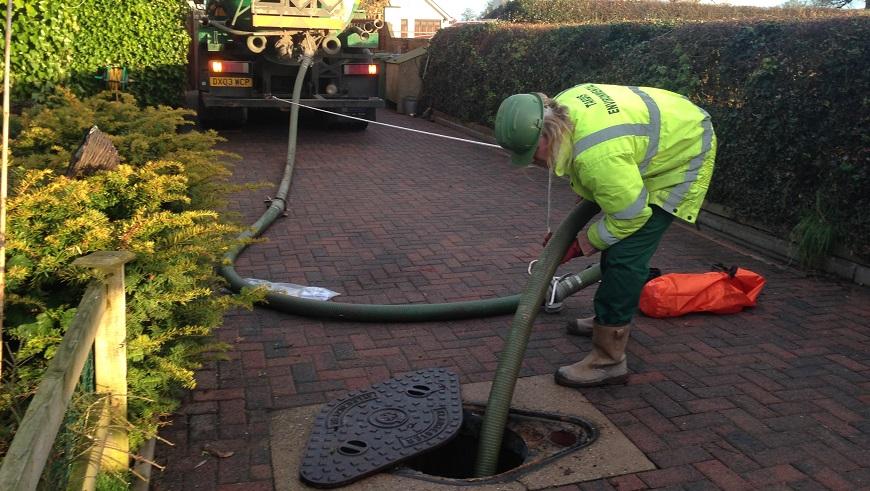
Table of contents
- How much does it cost to install a septic tank?
- Additional septic tank installation costs
- Labour cost to install a septic tank
- Factors that impact the cost of septic tank installation
- How do septic tanks work?
- What does installing a septic tank involve?
- DIY septic tank installations
- Choosing the right septic tank for you
- Septic tank regulations
- Septic tank maintenance costs
- Removing septic tank costs
- FAQs
- How to find and hire a septic tank installer
- Sources
How Much Does a Septic Tank Cost to Install?
Installing a septic tank is a common job if you’re living in a rural area as it’s difficult to access any mains sewage systems.
A septic tank will remove any "grey" water from running water including sinks, showers, toilets, and dishwashers.
There are five main factors you need to consider that can affect the price of a septic tank installation or the replacement of an existing septic system.
These are size, underground/overground location, drainage systems, material, and labour.
The average material cost for a medium septic tank would typically cost around £800, whereas a large tank would be around £1,200.
The typical size of septic tanks ranges from 4500 litres to 12500 litres, different sizes can alter the cost to put in septic tank as the bigger the tank, the longer the job will take.
The average septic tank installation cost including materials, labour and waste removal is between £1,500-£2,000.
This price will typically fluctuate due to ground excavation work, chosen materials, and waste removal.
Septic Tank Installation Prices
Below is the average cost of septic tank installation based on size and type.
| SEPTIC TANK COST | AVG. COST | DURATION |
|---|---|---|
| Single-chamber 4500 litres | £1,000-£1,500 | 2-3 days |
| Single-chamber 8500 litres | £1,700-£,2,200 | 2-4 days |
| Single-chamber 12500 litres | £2,000-£2,300 | 3-5 days |
| Multi-chamber 4500 litres | £1,600-£2,000 | 2-4 days |
| Multi-chamber 8500 litres | £2,000-£2,500 | 3-5 days |
| Multi-chamber 12500 litres | £3,000-£3,500 | 5-7 days |
How Much is a New Septic Tank?
Construction material affects your septic tank price — as you would expect, the better quality and longer lasting materials are more expensive. But it really is a case of getting what you pay for, so if you can afford the extra initial outlay, it’s worth paying a premium as the tank will last much longer.
Cheaper tanks are made of concrete, whereas the premium models are made of a high-density polyethylene material which will last much longer so is more economical over the long term.
Below is an average supply cost of either a single or multi-chamber septic tank when buying from an online retailer.
| TYPE OF SEPTIC TANK | AVG. INDIVIDUAL COST |
|---|---|
| Single chamber | £600-£800 |
| Multi-chamber | £1,000-£1,600 |
Below is an average pricing of the individual costs of popular materials for septic tanks.
| MATERIAL | AVG. COLST PER 1,000 GALLON TANK |
|---|---|
| Concrete | £600-£1,000 |
| Plastic | £700-£1,200 |
| Fibreglass | £1,000-£1,300 |
Concrete Septic Tank Cost
Concrete is the most common choice for septic tanks because it’s extremely durable and cheap in cost.
If a concrete septic tank is well maintained and looked after, it can last up to 30 years.
Concrete septic tanks may cost between £600-1,200.
Plastic Septic Tank Cost
Plastic is another budget-friendly option due to its light material.
Plastic septic tanks are not vulnerable to cracks; however, they may collapse due to soil pressure in harsh conditions.
Plastic septic tanks may cost between £700-1,500.
Fibreglass Septic Tank Cost
Fibreglass is a pricier option but comes with a range of benefits.
They’re easy to install due to their lightness and high quality.
Although the price is higher, it may be worth investing as fibreglass won’t deteriorate or crack underground, making it last up to 50 years.
Fibreglass septic tanks may cost between £1,000-£2,000.
Additional Septic Tank Installation Costs
There are some extra costs to bear in mind when looking at your complete septic tank price. While some are optional, the installation of a soakaway is generally a requirement.
Soakaway Installation
Installing a soakaway or other drainage field system should be done at the same time as installing your septic tank. In most cases, this has been a condition of regulations since 2020.
A soakaway allows wastewater to drain away, ensuring your septic tank safely discharges effluent.
The typical soakaway installation cost for a lawn is around £700. If you're replacing an existing soakaway, it will be around £600.
On average, soakaway systems need to be replaced every 10 years or so depending on their condition. If you're looking at replacement septic tank costs, consider whether it's time to replace your soakaway too.
Home Plumbing Work
It's a good idea to check all your home plumbing is in full working order and you're happy with it when considering your overall septic tank cost.
Think about the following options:
- Drain Jetting - You can have pipes leading from your home cleaned thoroughly to ensure they're in good condition. The cost of drain jetting is around £200.
- Update Fixtures - If you want to make your home plumbing system as effective as possible, consider upgrading your bathroom fixtures and fittings. While the cost of a bathroom suite is about £700, the cost to install a new power shower that might be more efficient is typically around £500.
- Replace Toilet - Upgrading your toilet could improve the efficiency of your home plumbing system. Toilet prices, including installation, are about £500.
While some of these will be unnecessary for your home, it's worth thinking about the overall stability of your drainage system when you're installing a new septic tank.
Septic Tank Cost Breakdown Calculator
Individual costs of installing an underground, medium-sized septic tank - Total Cost: £2000
Materials
£800
Tradesmen
£1100
Waste removal
£100
Labour Cost to Install a Septic Tank
A major cost factor is the labour required for the septic tank installation.
Typical installation labour costs are between £1,200 and £1,800 for a straightforward job.
This can be reduced if you can do part or all of the excavation yourself by hiring a digger, as it’s relatively simple to dig a hole.
The average septic tank specialist will usually charge around £150 to £250 per day, although labourers will often work in teams and labour costs will be factored into the overall price.
A septic tank installation can typically take anywhere 4-7 days to complete, depending on the septic tank’s size, material, and area of excavation.
For above ground septic tanks, it shouldn't take more than a day for installation so expect around £200 in labour costs on top of the cost to install septic tank.
Factors That Impact the Cost of Septic Tank Installation
Several key factors will affect your total septic tank cost.
While some of these costs can be reduced, it's important to work out whether that would translate to increased ongoing costs such as extra septic tank emptying, for example.
Size
The first and most obvious cost factor to consider is the size of the septic tank.
This will have a direct effect on the septic tank installation cost, but it is a false economy to install a tank that is too small, as this will just need emptying more often and will end up costing as much, if not more, than a larger septic tank.
You need to remember that septic tanks are not just used for sewage, they also take "grey water" from the washing machines, sinks, showers and dishwashers as well.
In fact, all the wastewater from your home will be draining into a septic tank so you need to ensure the tank has adequate capacity.
If anything, you should be on the side of slightly too large, as the extra installation costs would usually be cheaper than more frequent emptying over the long term.
A medium septic tank would typically cost around £700-£800, whereas a large tank would be around £1,200.
Above or Below Ground
Whether the tank is above or below ground also has a large impact on the price.
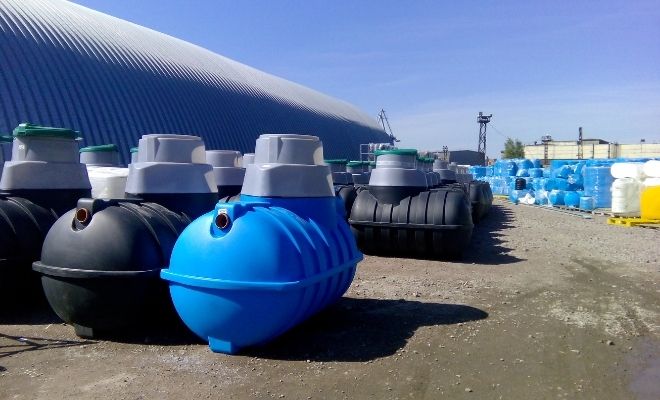
Underground septic tanks have additional costs in terms of excavation so above-ground tanks are generally cheaper and the best solution for minimising the septic tank price.
Having an underground tank fitted is not cheap due to the installation costs, but on small sites, you may have no other option if surface space is at a premium.
In addition, the larger sizes of septic tanks tend to be designed for underground usage.
Restrictions
When choosing you should always contact the local authority before making a decision, as they may have restrictions in place on the type of septic tank system you can use.
How Do Septic Tanks Work?
Septic tanks store and treat the wastewater from your home. Whereas most houses in built-up areas are connected to local sewerage systems, those in more remote areas may need their own solution.
Septic tanks separate incoming waste into layers so that sludge and scum can decompose under the action of essential microorganisms while wastewater drains away to a drainage field or a sewage treatment plant.
What Does Installing a Septic Tank Involve?
Septic tank installation should be carried out by a professional tradesman as it can be a dangerous job and requires specific expertise and qualifications.
Below is a general guide on the installation process of a septic tank done by a specialist.
Survey and Prep
The first step is to have a survey carried out on the site to ensure the area is ready for installation.
There also needs to be a soil test in and around the area where the septic tank will be.
Once the survey is completed, your septic tank is ready to be designed, after all building regulations and planning permissions have been complied with.
Excavation and Wastewater Systems
The work will begin with the ground being excavated and broken down to the right measurements, the hole will have to be at least 2 ft deep so that the septic tank can sit comfortably.
If the septic tank system is gravity fed, the wastewater will flow downhill from the tank so that it can be drained properly.
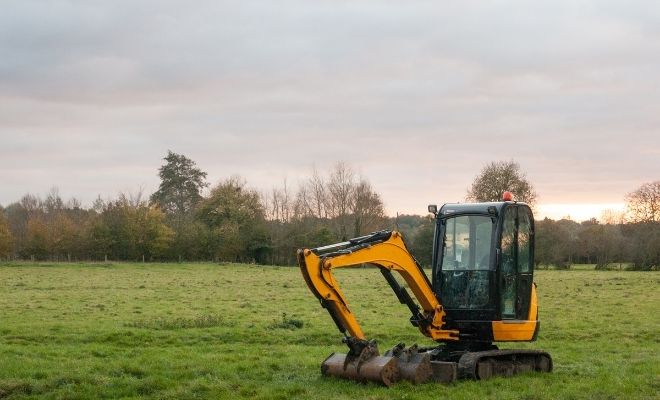
If the septic tank is using a wastewater dispersion method, then steel pipes will be installed through the trench wall, levelling into the ground.
Installation
Then, a substantial concrete tank will be installed below the ground within the excavated hole.
The survey will have planned the layout of the septic drain field which will be installed after this, specialists will ensure there is a positive flow between the tank and the leach field during installation.
Inspection
Once the septic tank is fit, all piping and uncovered bits will be covered up and finished aesthetically.
Once the health inspector gives the green light, your system will be good to go, and any extra works can be carried out.
Extras
If you’re having a pump chamber system installed, you’ll also need to have a chamber fitted right next to the septic tank.
This should be placed in after the septic tank has been installed and given the go-ahead.
A pump chamber system will transfer sewage to flow into the leach field where it will then be disposed of.
DIY Septic Tank Installations
It's technically possible to install a septic tank yourself, but it requires high levels of expertise and comes with risks.
You may increase your septic tank cost by undertaking work you're not experienced with and having to pay for the work to be remedied.
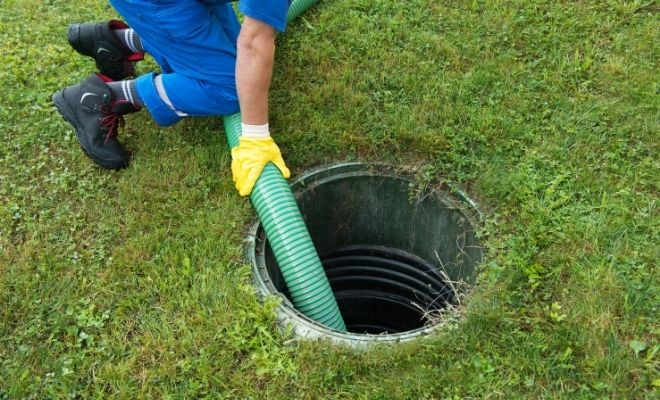
However, there are some ways to cut the cost of a new septic tank by taking on some of the non-critical work such as:
- Preparing the area by clearing weeds.
- Backfilling the area.
- Handling any post-installation landscaping.
- Ongoing maintenance work.
The temptation to cut septic tank costs by doing most of the work yourself is only feasible if you have experience in similar kinds of work and are comfortable, for example, with excavation work for underground tanks.
Choosing the Right Septic Tank for You
There are two main types of septic tanks which you can have installed into your housing system, these are either single chambered or multi-chambered.
Typical material choices include plastic, concrete or fibreglass as a septic tank system needs to be shielded from corrosion and water resistant.
Choosing the size of your tank will be determined by how many bedrooms your house holds, the more people in your household, the bigger the tank you’ll need.
Single Chamber Septic Tank
Single-chamber tanks are ideal for a small household as their main purpose is to hold heavy solids that have settled or floated from wastewater.
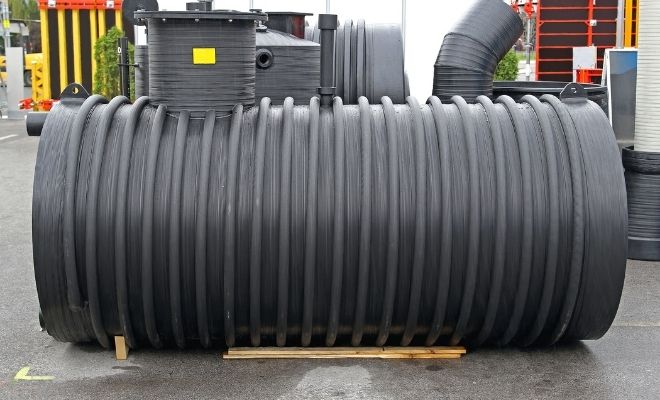
If you live in a one-bedroom house, it’ll be a cheaper alternative to install a single-chamber as the needs for a multi-chamber aren't as high.
Multi-Chamber Septic Tank
Multi-chamber tanks are great for bigger households that have a higher amount of effluent.
The multi-chamber will have a waste filter on the outlet which will stop solids from passing through, meaning there’s a slower process before effluent reaches the leach field and the system becomes clogged.
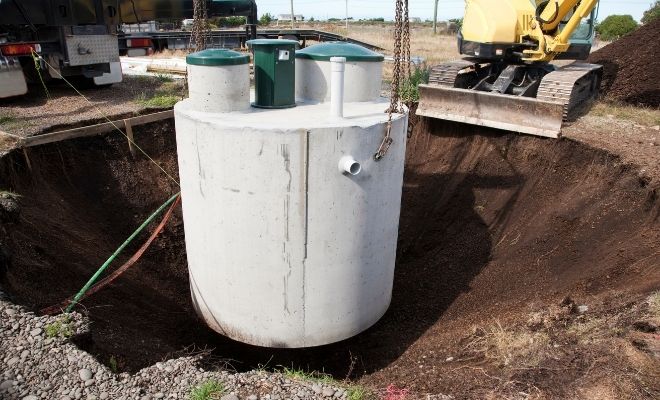
However, you’ll have to take into consideration that a multi-chamber will need to be cleaned and maintained far more regularly than a single-chamber tank and will add to the septic tank cost.
Septic Tank Regulations
There are specific building regulations in place that you need to follow before a septic tank installation, you’ll also need planning permission.
From 2020, new legislation has been put in place for sewage systems by the Environment Agency.
The regulations include discharging waste from your septic tank system via either a soakaway or waterway system.
Drainage systems are required for below-ground tanks which can also add to initial costs.
But the benefit of a larger underground tank can often be worth the initial expense at first.
This is because the soakaway can allow solids from the wastewater to be filtered out slowly into the surrounding ground, making sure that the tank does not need to be emptied as often, which will save you money in the long run.
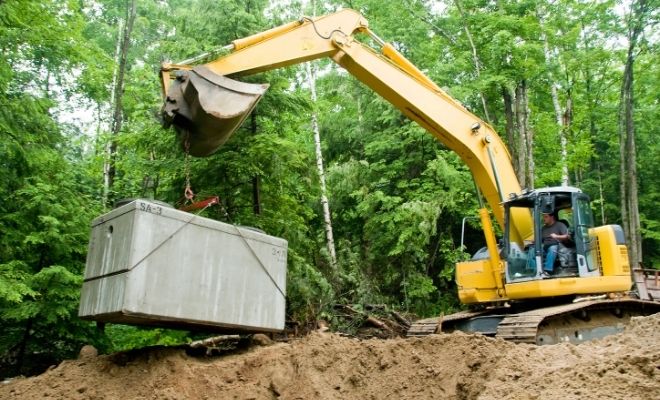
However, not all sites will be suitable for a soak away, the ground needs to be checked to ensure it will be able to absorb some of the excess water.
Getting this checked over and having any required pipe and drainage works installed will enhance the project’s price.
Full Planning Application fees, planning, can cost up to £1500 including design fees.
The price of application and liaison building notices will cost approximately £500.
Ensure that all planning permission and building regulations have been adhered to before getting quotes from professionals for the job.
If you fail to comply with building regulations and permissions, you may suffer a fine of up to £100,000.
Septic Tank Maintenance Costs
Urban dwellers usually take sewer systems for granted, but if you live in a rural area you will likely already know all about septic tanks.
If there is no mains sewage, then homes need a septic tank to provide a place for wastewater to drain into. Septic tanks need emptying at least once a year.
Although most of the sludge in the bottom of the septic tank is broken down by bacteria, it is likely that some sludge at the bottom of the tank will remain and this will build up over time so needs to be removed.
When you hire a contractor to empty the tank, they will take the sludge but put the watery effluent back in as this contains the good microbes necessary for your septic tank to work properly.
It’s really not emptying your septic tank, but simply removing the sludge.
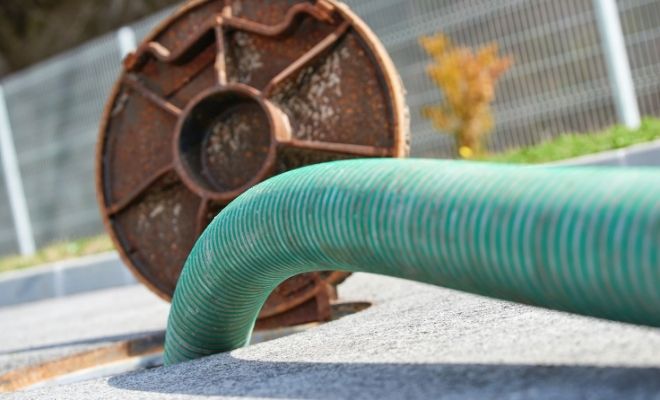
General maintenance should also be applied within the household when cleaning the pipes.
Make sure not to flush bleach into your sinks or toilets as it will kill any active bacteria within your septic tank and will lessen the effectiveness of your septic tank system.
If you choose a septic tank treatment which aids the growth of active bacteria, this will break down any solids or hard waste into sludge which will lessen any foul odours and stretch out the time needed before emptying your tank.
You can buy a year’s worth of bioaugmentation products from between £20 and £40.
Below is a table outlining the cost of general maintenance jobs.
| JOB DESCRIPTION | COST | TIMEFRAME |
|---|---|---|
| Emptying a small septic tank | £100-£150 | Under an hour |
| Emptying a large septic tank | £200-£250 | 1-2 hours |
| Replacement soakaway system | £500-£700 | 1 day |
Removing Septic Tank Costs
Your septic tank may need to be removed and replaced if there’s blocked pipe in your household, a blocked filter system, flooding, or if there’s an unpleasant odour coming from your garden.
This happens when a septic tank is damaged, and you may need to fork out for a replacement.
If you hire a company to come and empty your septic tank, they will find the cause of the problem and either help you out with a quick fix or give you the unfortunate news that you need a new septic tank or drainage system.
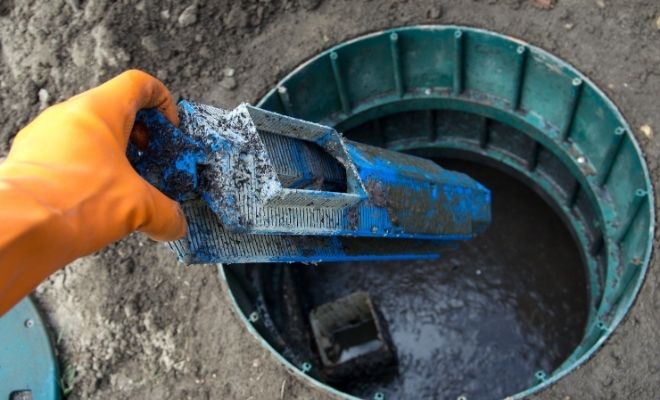
Costs can differ depending on the reason why your septic tank needs replacing.
If you’re lucky, your replacement could be covered by your building insurance, meaning you will only have to pay for the excess which is usually up to £100.
However, if you need a whole new tank to be installed, this can cost anywhere between £1,000-£3,000.
FAQs
They are usually installed where there is no mains drainage and are buried in the ground.
The sludge itself is then broken down over time by naturally occurring microbes.
Water-based cleaning products are a good choice for cleaning your household, as well as most multi-purpose household cleaners.
You may be able to get away with small amounts of household bleach, but any high strength or extra strong bleach should be avoided.
The baseline value is a 3-bedroom house, which is assumed to potentially house 5 people. Each person is then assumed to produce 150L of wastewater per day. This gives 5 x 150 = 750L. Then add a flat 2,000L to the final value, giving you 2,750L. Always round up when determining the septic tank size to buy, so any product above 2,750 will work.
For houses with more than 3 bedrooms, simply assume one extra person per bedroom and update the calculation. For example, for a 5 bedroom house: (7 x 150) + 2,000 = 3,050L. For more information, check out British Water's "Flows and Loads - 4" document.
Whereas waste-water treatment plants usually have an electricity supply which drives a small pump to aerate the wastewater and break it down so that no soak-away is required.
In a perfect environment this is not necessary as the biomass will be self-sustaining, but some strains of bacteria find it harder to thrive in a septic tank than others, so regular bio-augmentation guarantees your tank has sufficient bacteria of the right kind in it.
It’s important to make sure your installation is high quality, even if that adds cost to put in the septic tank.
How to Find and Hire a Septic Tank Installer
When hiring a contractor to install your septic tank, you want to ensure that you have a specialist who is skilled, trustworthy, and qualified to complete the job. It can seem like an overwhelming task to find the right person to hire, but we’re here to help.
Below is a list of questions you want to ask potential installers when talking with different tradesmen and comparing quotes.
Qualifications
Make sure you ask for proof of whether they have the correct qualifications including:
- General Liability and Workers Compensation insurance
- Installer license through Texas Commission on Environmental Quality (TCEQ)
Ask For Pictures and References
Check that they’ve undertaken this job before and have prior experience with installing septic tank systems.
Seeing previous pictures and hearing from their other customers will give you an insight into how your installation will turn out and how reliable they are.
Checking out their work will also give you peace of mind and make sure they’re not all talk.
However, if they refuse to let you see any pictures or hear references, then it may be best to look somewhere else.
Compare Quotes
Comparing quotes is the best way to make sure you’re getting the best deal possible.
It’s also a great way to fish out anyone who may be upping their prices to a layman.
Comparing several quotes will let you see the general price range of your specific job.
Set Up Payment Plan
Once you’ve found your tradesmen and have agreed on a quote, dates, surveying, and all the rest, you should set up a prior payment plan through either direct debit or cash.
Make sure to ask for a receipt to avoid any potential future disputes or problems.
Sources
https://www.crystaltanks.com/septic_tank_installation.html
https://theconstructor.org/building/types-septic-tank-materials/32514/
https://cdn.ymaws.com/www.britishwater.co.uk/resource/resmgr/publications/codes_of_practice/flows_and_loads___bw_cop_18..pdf






